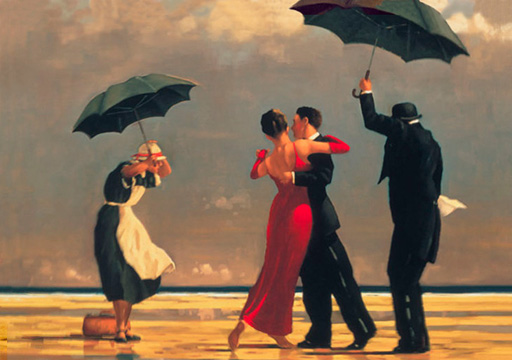
While I can indulge in the latest quirky selection at the Sundance Film Festival as well anyone, I am also quite susceptible to enjoying the latest swashbuckling blockbuster from Hollywood, too. Rotten Tomatoes can dissect the political symbolism and daring originality of a film all they want, but when it comes to flat out entertainment, I say Indiana Jones beats Last Tango in Paris every time. If critiques of such mediums were democratic, most reviewers would be out of the job. This snobbish circle of condemning connoisseurs exists in the art world as well. Twentieth century artist Jack Vettriano, for example, has been labeled “unimaginative” and “sexually rampant” by these predatory critics. But accusation is a luxury of those on the sidelines, and if pleasing the masses brings Jack Vettriano happiness, I say his soul has not been sold.
A man with a knack for painting, Vettriano put his skills to work on the subject that interested him most: women. Vettriano once told his house journal, Scotland on Sunday, that the art world "doesn't like rampant heterosexual behavior. Somehow, they think that it is a bit tawdry, not what real art should be." With paintings ranging from a couple dancing on the beach to a woman in scant clothing engaged in a steamy act of foreplay, the elite of the artistic community stuck up their noses and considered him gutter-brained rather than gifted. The rest of society, however, took to his work almost immediately, propelling him to a popularity rarely rivaled in the realm of art. His painting The Singing Butler became face of the most distributed postcard in all of Europe once it was published. To his critics’ dismay, the fantasy of dancing on the sands while being serenaded by a butler captivated the imaginations of millions more effectively than Monet’s lily pads ever would.
In her article “The People’s Choice,” Jacqueline Harrett’s agrees with the critics who bash Vettriano work, claiming that “popular art is not necessarily good art.” She also points out that none of Vettriano’s paintings hang in national galleries and describes his work as lacking perspective, depth and texture, and having a uniformity of style that borders on monotonous. Furthermore, she criticizes his lack of originality by supporting the notion that he allegedly mixed and matched details from his favorite photographs to create his paintings. Ultimately, she takes the thumbs-down perspective and condemns Vettriano as charlatan, proclaiming his work to be amateurish and lacking in any true artistic style or direction.
But take Vettriano’s most popular piece, The Singing Butler. Does it not possess the same graceful angularity, the same play of light and shadow as one of Pierre-Auguste Renoir’s famous dancing couples? Better yet, Mr. Vettriano’s piece suggests a heightened sense of occasion, an emotional endearment unmatched by the classic French painter Renoir. The eye is drawn to the woman in the red dress, her face turned away from the viewer, leading one to wonder what beauty the painter has chosen to hide. The subtle coexistence of evening sunlight and grayish-purple rainclouds above can also be seen reflected in the puddles in the sand and the in ocean surf in the distance. The flapping of the Maid’s dress and the slant of the umbrellas create a sense of movement, of wind that cannot interrupt the intimacy of the dancing couple. Does this sound lowly? Does this sound vulgar? I think not.
With these thoughts in mind, I refute the uppity claims of the so-called artistic elite, and personally recognize Jack Vettriano as a talented painter capable of capturing the spirits of millions. His use of color and brush techniques may not be revolutionary, but art doesn’t necessarily have to be revolutionary to be done well. I say, Mr. Vettriano, you have done well.
No comments:
Post a Comment